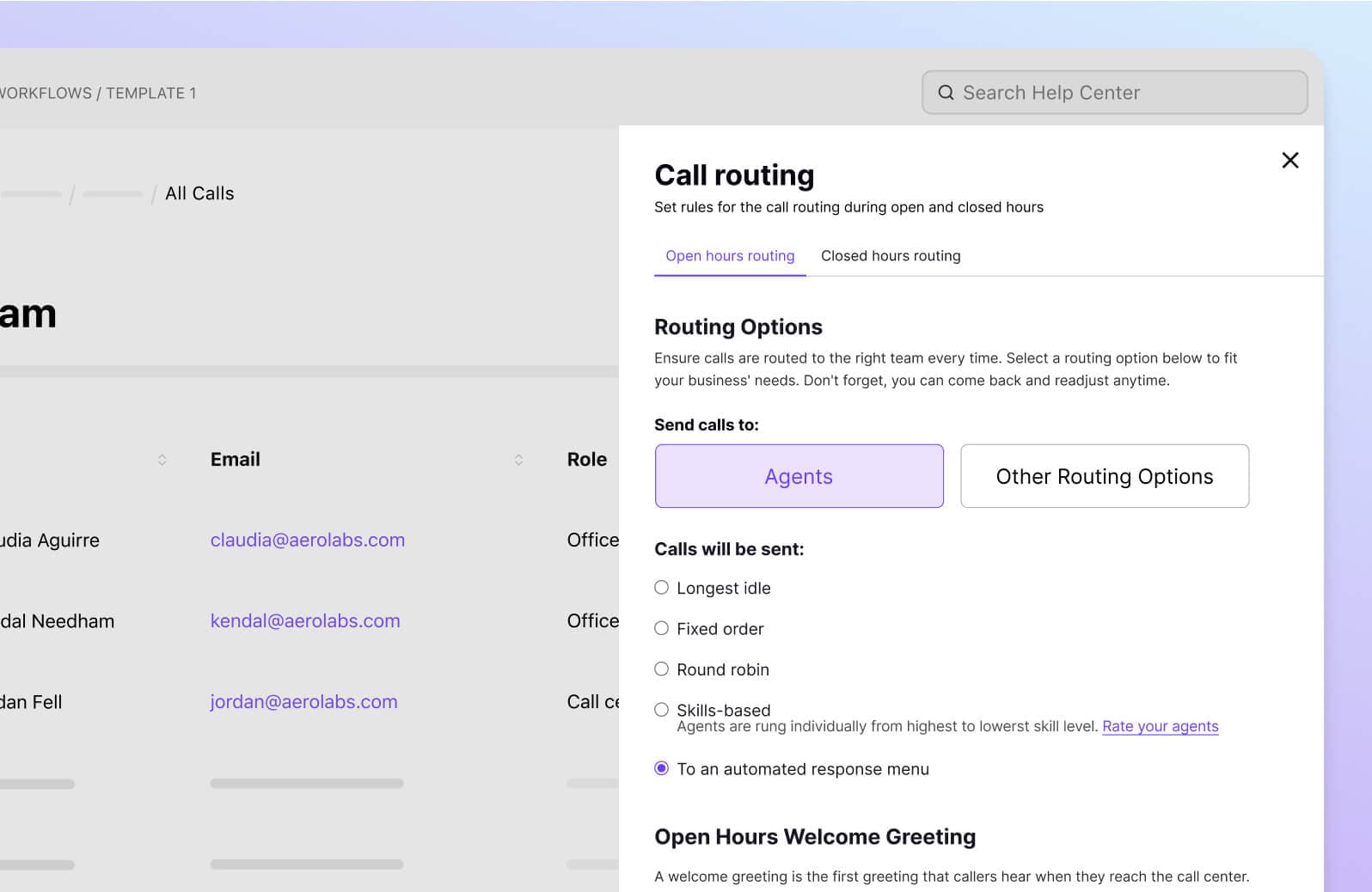A guide
Digital transformation roadmap
Learn how to build a digital transformation roadmap to improve business efficiency and enhance customer experiences. Or, if you're looking for a solution to transform your business communications, book a product tour of Dialpad's AI-powered collaboration platform!

As a technology leader, you should always be thinking about how you can scale your business faster, better, and more securely. How can you make your internal systems more flexible, yet reliable?
The answer is something many of you have certainly heard of: digitization.
Today, more and more companies are digitizing their operating models to gain a competitive advantage, and rightly so. Digital transformation is an essential next step for many organizations, and one reason why is because it makes the business more scalable.
For a digital transformation project to be effective, however, one needs to build a proper roadmap. A digital transformation roadmap is a documented process for adopting digital technology and new processes in order for the business to better achieve strategic business goals.
Key goals are top-line growth and increasing the business value. A digital transformation roadmap can help meet these goals by mapping out the process improvements, IT infrastructure upgrades, software tools, automations, establishing a system of record, and technical training needed to streamline customer operations, communication and improve customer experience.
In this guide we will share some hard-won insights drawn from the experiences of our executives, colleagues, and customers.
👀 Other CIOs are thinking about digital transformation, too
Read real CIO insights about switching from on-prem to cloud communications.
6 key considerations when building a digital transformation roadmap
Planning out your transformation process to digital is a complex, weighty process for any business—enterprise or not—with a tremendous impact on both your organization and your customers.
With that in mind, we have some suggestions that will help with decision-making as you build an achievable and effective digital transformation roadmap.
1. Perfect your process first
If you introduce a tool into a broken process, then you just end up making things worse, not better.
When it comes to digital transformation, optimizing a process should always come before introducing a new tool. This is done to make sure the first steps of your digital transformation are headed in the right direction. Introducing a tool without first reviewing the process may just end up causing more inefficiencies in the long run.
When evaluating your process, you should ask yourself what problem you’re trying to solve. Question your assumptions and keep asking “why” until you get to the true root cause of the problem.
For example, your contact center might have an operator or tier 1 team of agents who act as the customer’s first point of contact. Their responsibility is to answer basic questions and redirect them to the appropriate department. But this process is time-consuming, ties up one or more trained agents, and can only handle a limited volume of calls.
Consider evolving this process from manually-managed routing to something that’s more automated. Once you know you want to automate this process, then you can look at tools like an IVR system or an enterprise phone system that can make that happen.
Dialpad's collaboration platform, for instance, would let you change your call routing settings from an online dashboard:

👉 Tip from our CIO:
You should be forward-thinking when you review your process. Don’t just solve today’s problems—try to anticipate challenges as well. Ideally, you should be looking ahead for the next five years.
2. Consider how process translates to new technology
The role of technology in digital transformation isn’t just to move business processes online, but to make processes better.
How can technology streamline a process in such a way that it is faster, more efficient, and produces greater customer value than the old, manual way? How well do your digital capabilities match customer needs?
One way of doing this is via connectedness. Specifically, the connectedness of your tools. Make a business transformation roadmap where your software systems talk to each other through native integrations, such that they connect from front-end customer experience to back-end operations.
For instance, the sales team has a process where they must document interactions with prospects in order to keep better track of deals and help them provide more tailored buying experiences. While adding a CRM would be effective at storing and managing the information, it can be clunky to update and view. The transformation is not yet complete.
So the sales team modifies the roadmap to include a communications platform that can integrate with their CRM. For example, they might use something like Dialpad's AI-powered customer engagement platform, which integrates with Salesforce to make it easy for reps to log call and SMS conversations:

In doing so, they can ensure that customer interactions are quickly imported into the CRM and are easily retrievable by those who need it.
This transformation plan leverages systems and applications that improve the organization’s process as a whole and has a net positive net impact on the business.
3. Digital transformation is about more than just technology
If digital transformation were just about buying software, then every business in the world would be digital by now.
On the contrary, there’s far more nuance to the digital transformation journey than most people appreciate, and this is often what sinks transformation projects.
It’s about the people you’re hiring
Are your employees good with technology? How quickly can they adapt to using new software? How well can they adopt the new procedures? How resistant are they to cultural change?
Also, how many stakeholders are being impacted by the change? Which departments? Does the change also impact customers directly and how they interact with your company?
It’s about the processes you’re building
Remember that the software you’re introducing is just a means to an end. The process is the main concern here, not how shiny and new the application is.
It is absolutely possible that a new piece of software can work well and as designed, but not make any process efficiency gains. Just buying the software isn’t enough to transform the organization—a business has to build and enforce a process that uses the technology to its best advantage.
If we go back to our CRM integration example, they might implement Salesforce in order to streamline workflows for their sales team and make customer intelligence more accessible—but then neglect to implement a policy where sales reps are required to record specific details of a customer interaction and maintain data hygiene. Nothing about the process improves, despite having tools that can help.
It’s about the systems you’re developing
When constructing your digital transformation roadmap, always be mindful of the initiative’s effect on current systems.
How does the software you’re introducing plug in to the rest of your tech stack? Are you replacing the entire system, or just one part of it? What will the end result of this change be to the rest of the company?
Also, how well does this new system align with the overall business strategy? What kind of metrics and KPIs can you track to ensure that this system is working as intended? What data analytics can you provide to stakeholders?
4. Digitize customer-facing processes first
Customer-facing processes are always a good starting point for digitization. They’re your revenue driver, and so anything on the value chain should get first priority.
In general, there are two driving factors for retaining customers and growing the business: customer experience, and giving the customer the best value to the price they’re paying. So, when you think about your digital transformation roadmap, consider the following questions:
Are we driving the right leads to convert?
Once converted, how do we keep them?
How can we sell them more?
How can we make their experience world-class?
In answering these questions, you’re ensuring that your digital transformation roadmap is focusing on what’s really important to business growth: the customer journey.
5. Do the homework first
One of the biggest mistakes people make in digital transformation is not doing the homework.
👉 Tip from our CIO:
Your digital transformation will take your company places—whether it’s a good or bad place depends on how much you prepare. “Measure twice and cut once” is a very important philosophy for me when buying enterprise applications.
Before taking action on your digital transformation roadmap, you need to know:
What problem you’re trying to solve
Why you’re getting a new software or tool
Whether or not it’s the right time
How the tool you get is going to transform the customer experience
Then, after you do your due diligence, you have to shop.
Look at reports from Gartner and other industry publications that can help you identify prominent players in whatever product market you’re interested in. Ask your peers for recommendations.
And once you start looking at products, don’t buy the first option you encounter. Make sure you choose at least two to three competitors and test your use case against them. Proof of concepts will go a long way towards ensuring you make the right decision.
When evaluating your options, ask yourself:
What can easily fit into your ecosystem?
Does this fit business requirements?
What additional problems does it solve?
Is it secure? Available? Reliable?
If you shortcut this process, you may run into pitfalls where you see amazing features and buy immediately based on those sales demos, without considering whether those features are truly necessary. (And sometimes features that we see in demos are in beta or won’t actually be available for some time!) That may lead you down the wrong path, and eventually reach a point of no return where you’re too deep into a project and can’t turn back.
6. Have a change management plan
Picking the right tool is important, but so is the implementation. People often neglect to account for change management in their roadmap and assume people will “just get used to it.”
The consequence of this attitude is a poor tool adoption. Without user adoption, you’re not going to see ROI out of your expensive new digital transformation, and things will either revert back to the way they were before, or you’ll end up blaming the tool and buying a new one.
Change management isn’t just about training people to use the software. It also involves finding a small cohort of people who can give you proactive feedback, and then using that feedback to fine-tune the system in preparation for a wider rollout.
A good implementation partner will help with that. Sometimes the software company that supplies the tool can provide project management support for a fee—other times you may need to hire a third party team to run the implementation program for you.
Interested in how Dialpad assists in digital transformation?
Telephony systems are a very common digitization project, with many business leaders migrating away from legacy PBX systems and towards cloud-based unified communications platforms like Dialpad.
Dialpad’s advantage in this area is how easy and fast it is to set up and deploy for large organizations with global teams. The timeline for setting up is unlike any legacy system: one of our enterprise customers even managed to set up their new contact center in 10 minutes (which makes for a much shorter roadmap).
It also helps that Dialpad’s services cover a wide range of communication needs to help solve multiple business use cases. Basic voice, video, and SMS/MMS communication are supplemented with advanced contact center functions such as IVR, agent coaching, and live transcription.
If you’d like to talk to someone knowledgeable about digital transformation and the best strategies for planning and executing them, we can help. Simply reach out to our team to learn how to undergo a successful digital transformation.
See how Dialpad can help your digital transformation roadmap
Dialpad’s fast setup and easy scalability make it easy to incorporate into any digital transformation roadmap. Book a demo or take a self-guided interactive tour of the app on your own!
